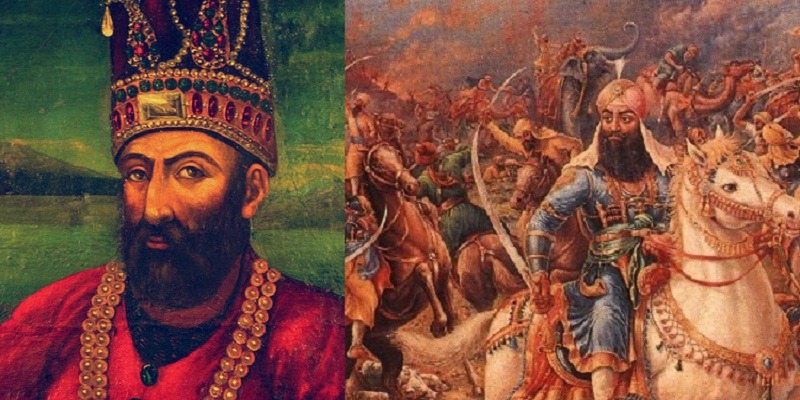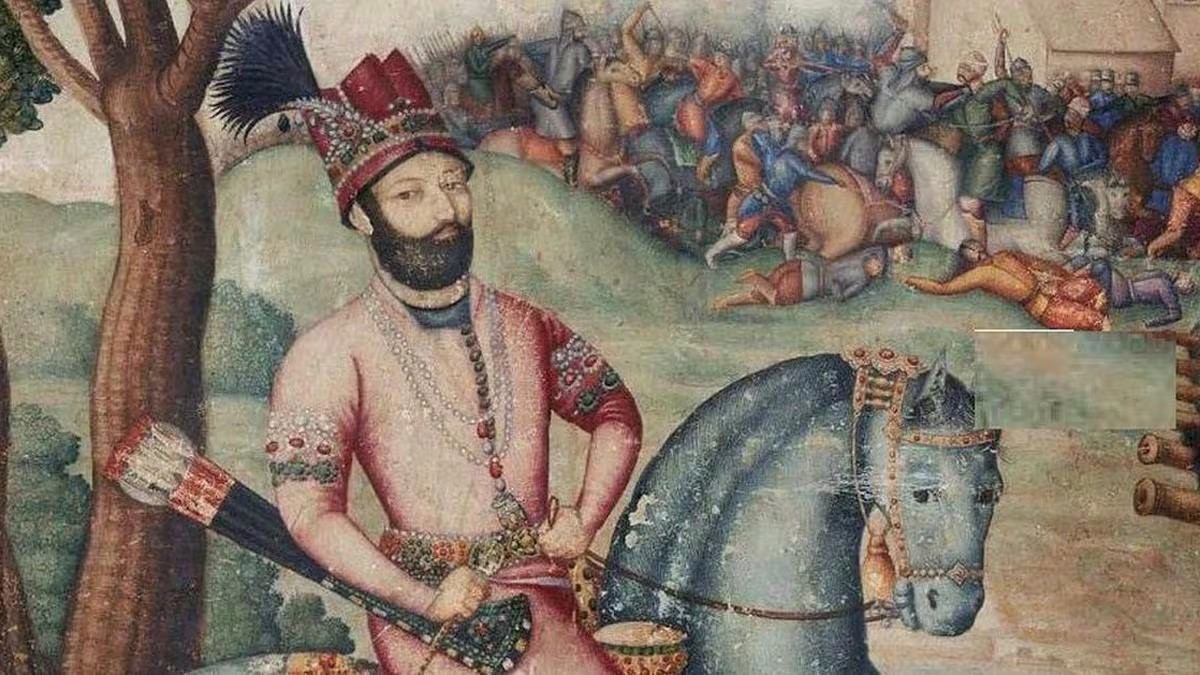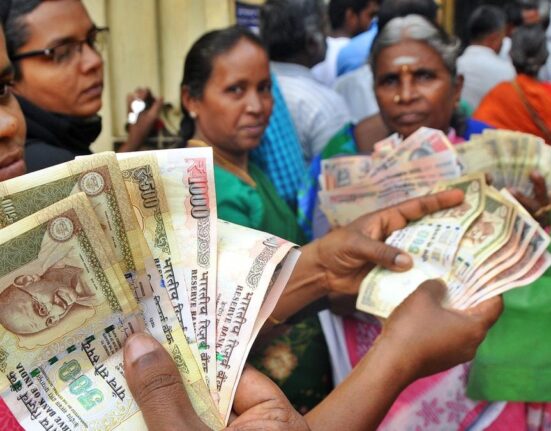परिचय
In 1739, Nadir Shah of Persia invaded northern India, destroyed the Mughal army at Karnal, entered Delhi as master, and unleashed one of the most brutal sackings in the city’s history, carrying off the Peacock Throne, the Koh-i-Noor and Darya-i-Noor diamonds, and an immense treasure that crippled the already-declining Mughal state. The invasion exposed the Mughal Empire’s military and administrative decay and accelerated its terminal decline, reshaping the subcontinent’s political trajectory in the 18th century.

Background and March to India
Having consolidated power in Iran—crowned in 1736 after a series of victories including Damghan (1729)—Nadir Shah turned east, capturing Ghazni, Kabul, and Lahore in 1738 as he advanced through the Khyber into Mughal territory weakened by post-Aurangzeb wars, factionalism, and disrepair. Diplomatic frictions and court intrigues—along with reports of vast, vulnerable wealth in Delhi—reinforced his decision to push toward the imperial capital after securing the Punjab. By early 1739 he had broken Mughal frontier defenses and drew the imperial army into a pitched battle on the plains near Karnal.
The Battle of Karnal (24 February 1739)
- Opposing forces: A large Mughal army—contemporary estimates give upwards of several hundred thousand including elephants—confronted roughly 50,000–55,000 disciplined Persian troops equipped with superior musketry and field artillery.
- Tactics and collapse: Nadir Shah drew the Mughals into close range before unleashing coordinated volleys of gunfire; war elephants proved easy targets, and key commanders were killed or captured—Khan Dauran mortally wounded, Sa’adat Khan taken prisoner—triggering a rout within hours.
- Aftermath: Muhammad Shah surrendered, effectively becoming Nadir’s captive; with the imperial army shattered, Nadir Shah marched on Delhi to dictate terms in person.
Britannica emphasizes that Karnal represented “the effective end of the Mughal Empire,” clearing the way for Nadir’s entry into Delhi and the systematic spoliation of its wealth and prestige.
Entry into Delhi and the Massacre
Nadir Shah entered Delhi on 20 March 1739 and briefly maintained order; khutba and coinage were issued in his name as sovereign, marking the eclipse of Mughal authority. Two days later, a rumor spread that Nadir had been killed, leading to attacks on Persian soldiers; Nadir retaliated with a general massacre and sack of the city.
- Scale of killings: Contemporary and later estimates vary widely—many reputable accounts cluster around 20,000–30,000 civilians killed in a single day of mass slaughter (22 March), though some sources report far higher figures.
- Cessation: At Muhammad Shah’s entreaty, Nadir eventually ordered the killing stopped, but only after horrific devastation across neighborhoods where Persian bodies were found.
Wikipedia’s consolidated account cites 20,000–30,000 killed within six hours, plus mass enslavement of women and children; other syntheses present broader ranges, underscoring the uncertainty but not the brutality.
The Plunder: Peacock Throne, Koh‑i‑Noor, and the Imperial Treasury
The sack yielded an unparalleled treasure haul:
- Imperial regalia: The Peacock Throne and the great diamonds—Koh‑i‑Noor and Darya‑i‑Noor—were seized as symbols and substance of Mughal wealth.
- Treasury and levy: Nadir levied an enormous fine (often cited as 20 million rupees) and compelled Muhammad Shah to hand over the keys of the treasury; bullion, jewels, and cash were stripped from court and city alike.
- Wider spoils: Chroniclers recount the removal of precious metals, animals, skilled artisans, and vast numbers of captives and pack animals—an organized spoliation that left Delhi economically prostrate.
Britannica and standard histories agree the loot included the Peacock Throne with embedded jewels and the famed diamonds, while Indian syntheses add large numeric estimates for gold, jewelry, and cash to convey the scale of extraction.
Political Terms and Withdrawal
Nadir Shah remained in Delhi for roughly two months before marching home on 16 May 1739, having imposed terms that formally humiliated but kept Muhammad Shah on the throne. In the geopolitical settlement:
- Western provinces: Mughal lands to the west of the Indus—Kandahar and adjoining regions—were ceded to Persia, fixing a new frontier at the Indus and diminishing Mughal reach.
- Restoration east of Indus: Some accounts note that while Nadir devastated and overran territories east of the Indus, he withdrew from them, leaving the emperor on a hollow throne and the capital stripped of means to rebuild.
The net result was a stark imperial downsizing and delegitimization: the emperor remained in Delhi, but the empire’s resources and aura of invincibility were gone.
Why the Mughals Collapsed at Karnal
Several structural and immediate factors compounded:
- Military obsolescence: The Mughal reliance on massed cavalry and elephants, poor fire discipline, and lack of cohesive command proved helpless against compact formations, mounted musketeers, and coordinated artillery fire.
- Factionalism and poor leadership: Court rivalries undermined unity of command; the deaths or capture of senior commanders during battle sparked panic and disintegration.
- Logistical mismatch: Nadir’s lean, drilled force maneuvered and concentrated firepower quickly; Mughal numbers and animals clogged the field and magnified chaos once pressure mounted.
Human Toll and Urban Catastrophe
Delhi’s experience in March 1739 remains among its darkest episodes:
- Mass killing: Estimates commonly cite about 30,000 civilians killed; some broader ranges go higher, reflecting the difficulty of counting amid mass burials and pyres.
- Social trauma: The slaughter, rapine, and enslavement, followed by forced indemnities, collapsed urban life and commerce; corpses reportedly filled streets, and many residents resorted to suicide to escape assault.
- Cultural loss: The sack disrupted patronage networks, expelled or killed artisans, and stripped ceremonial objects, degrading Delhi’s status as a cosmopolitan imperial capital.
Consequences for India
- Mughal decline made manifest: Karnal and the sack shattered the mystique of Mughal power, leaving the court financially crippled and militarily discredited, with authority increasingly symbolic.
- Frontier re-drawn: Loss of territories west of the Indus irreparably contracted the empire and emboldened regional and foreign challengers.
- Cascade of invasions: Ahmad Shah Abdali (Durrani), a one-time Nadir lieutenant, established his Afghan state after Nadir’s death and invaded India repeatedly (1748–1767), culminating in the Third Battle of Panipat (1761).
- Opening for the Company: The invasion laid bare imperial vulnerabilities, alerting the British East India Company to the opportunity for political expansion in the wake of Mughal collapse.
Timeline (Key Dates)
- June 1738: Kabul falls to Nadir; the road into Hindustan opens via the Khyber.
- 24 February 1739: Battle of Karnal; Mughal army destroyed; Muhammad Shah captured.
- 20 March 1739: Nadir Shah enters Delhi as de facto sovereign.
- 22 March 1739: Massacre and sack of Delhi; tens of thousands killed.
- 16 May 1739: Nadir departs Delhi with treasure; frontier fixed at the Indus in Persia’s favor.
परंपरा
Nadir Shah’s India campaign ranks among the most consequential external incursions into the Mughal heartland since Timur: it delivered a decisive military humiliation, extracted the symbolic and material heart of Mughal sovereignty, and precipitated a rapid unraveling of imperial cohesion that reconfigured South Asia’s political order for the remainder of the 18th century.
Interesting Facts
- The Peacock Throne, centerpiece of Mughal court ritual, became a Persian imperial emblem after its seizure—an unmistakable transfer of prestige across empires.
- The Koh‑i‑Noor and Darya‑i‑Noor, removed in 1739, later entered the British and Iranian crown jewels respectively, embedding the invasion’s legacy in two separate national treasuries.
- Despite devastation east of the Indus, Nadir kept Muhammad Shah on the Delhi throne—a puppet left to preside over a hollowed treasury and fracturing realm.

निष्कर्ष
Nadir Shah’s invasion culminated in a short, devastating occupation of Delhi that broke the Mughal state’s fiscal backbone, stripped its symbols of legitimacy, and exposed its military and administrative decay beyond doubt. Karnal’s battlefield destruction and Delhi’s subsequent massacre and plunder turned the empire’s decline into free fall—inviting Afghan incursions, empowering regional powers, and paving a clearer path for European ascendancy in India.








इस बारे में प्रतिक्रिया दें